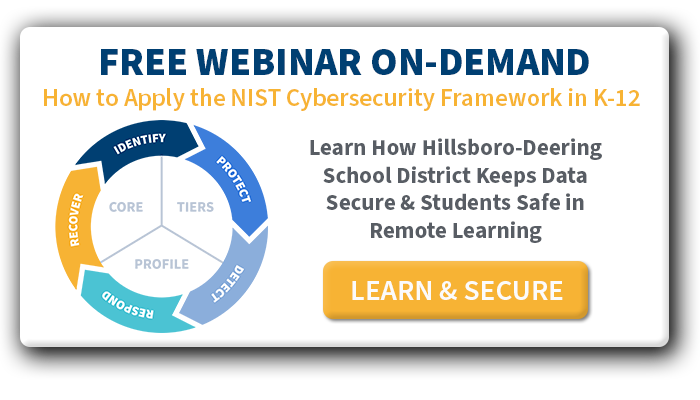Zero Trust Cybersecurity for K-12 School Districts
Zero trust cybersecurity is a never trust, always verify approach that K-12 districts need now more than ever
For many years, school districts relied on network perimeter cybersecurity such as firewalls and web content filters to protect their systems against cyberattacks. Today, perimeter-based cybersecurity is dead. It was before COVID-19 sent school districts scrambling to provide remote learning, and it certainly is now after the fact.
Today, districts need to use zero trust security. With zero trust cybersecurity, your systems don’t trust anyone by default, regardless of whether they are inside or outside your network. Anyone accessing your systems from anywhere must be verified to gain access to your data and their behavior monitored the entire time they’re using data and apps.
Why Zero Trust Cybersecurity?
Zero trust cybersecurity focuses on securing your data rather than just the perimeter of your network. This approach secures your district’s data more effectively, regardless of the network or device a student, teacher, or staff member is using. Taking this approach is particularly important for districts that are using remote or hybrid learning. In those environments, you have no way to know whether the networks that your users employ are secure or not.
Another benefit to zero trust cybersecurity is that it secures your data regardless of the device your end users are on. You may be in one of the districts that were able to scramble to full 1:1 for the 2020/21 school year. But, it’s impossible for you to know if everyone accessing your district’s Google Workspace and/or Microsoft 365 applications are using their school-issued devices. It’s not unheard of for a student to leave a device at school, and then login with their home computer to do homework.
On the other hand, if you have your 1:1 Chromebooks on backorder, or if you don’t have the budget for 1:1, or your district has decided to use and your district is using BYOD vs. 1:1 you shouldn’t leave your district’s cybersecurity up to chance.
3 Zero Trust Cybersecurity Advantages for School Districts
Besides providing better overall data security, zero trust cybersecurity has three key advantages. It protects you from users on any network, it provides more cybersecurity layers, and it helps you to prepare for emergencies.
1. Zero Trust Secures Data from Any Network Access
Many districts have internet accessibility challenges. In those districts, users rely on public networks to do homework, attend class, teach, and grade assignments. Perimeter security like firewalls and content filters won’t protect your district’s data from bad actors exploiting public network access.
Home networks are also notoriously dangerous, as many people don’t realize the risks of not updating their firmware or changing their internet access password.
2. Zero Trust Means More Layers of Cybersecurity
School districts that have suffered from ransomware attacks had cybersecurity in place. The problem is that criminals can and do find their way past perimeter defenses. Zero trust cybersecurity frameworks suggest a multilayered cybersecurity tech stack.
It allows you to protect your perimeter, but even more important, you can also monitor for abnormal behavior within your information systems. Once your system spots a user exhibiting abnormal behavior, you can control what that particular user is allowed to access and do.
3. Zero Trust Prepares Your District for Emergencies
No one got out of the COVID-19 problems unscathed. Schools closed, then reopened, then some closed again. However, those districts that had a zero trust cybersecurity strategy in place, or had at least made good progress into putting one in place, were in a better position overall from a data security and student data privacy standpoint.
When emergencies arise, zero trust cybersecurity is the only method that will make sure you are prepared. As in the case of COVID-19, districts using a zero trust strategy didn’t need to worry as much about access from public and/or unsecured networks. Nor did they worry as much about students and staff returning to school and bringing malware with them that had been dormant, but was now poised to attack the schools’ networks.
Zero trust gave them the security, visibility, and control they needed no matter where users logged in from, or what device they were using.
3 Zero Trust Cybersecurity and Your Data Castle
Data is now perhaps the world’s most valuable resource. Criminals are trying to get your student, faculty, staff, and district business data.
In Medieval times, a castle had a moat and walls. But, they also had knights and mercenaries inside the walls who were there in case the wall was breached. Think of zero trust as your modern-day castle, which uses every defense and response tactic available.
Zero trust cybersecurity is “defense in depth.” The zero trust framework encourages you to look at your information systems’ various layers. It’s a never trust, always verify approach that K-12 cybersecurity needs now more than ever.
Are you ready to start or refine the development of your district’s zero trust strategy? If so, you’ll want to attend our webinar titled “How to Apply the NIST Cybersecurity Framework in K-12.” You’ll hear from Neal Richardson, Director of Technology at Hillsboro-Deering School District, on how he and his team implemented zero trust cybersecurity using the NIST Cybersecurity Framework.
The post Zero Trust Cybersecurity for K-12 School Districts appeared first on ManagedMethods.
*** This is a Security Bloggers Network syndicated blog from ManagedMethods authored by Katie Fritchen. Read the original post at: https://managedmethods.com/blog/zero-trust-cybersecurity-k-12/




![[FREE WEBINAR] How To Apply The NIST Cybersecurity Framework in K-12. LEARN MORE & REGISTER >>](https://no-cache.hubspot.com/cta/default/6834707/4a72c818-7668-44b3-9457-a116b34731ef.png)

